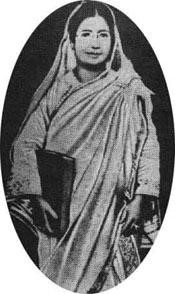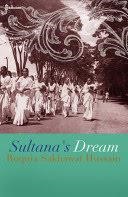Sinjini Chatterjee is an MA student at SOAS University of London.
Sultana’s Dream: An alternative view of colonial Bengal.
‘You need not be afraid of coming across a man here. This is Ladyland, free from sin and harm’.
Rokeya Sakhawat Hossain’s ‘Sultana’s Dream’, published in The Indian Ladies Magazine in 1905 (Lakhi,2006:2), is a prominent short story where the author presents an utopian world (a form of ideal society that has no existence) where men are banished to the mardana while women rule the country. In a time when education of Muslim women was discouraged and they were majorly in purdah, this story written in English, advocates for women education and equality in colonial India. This post-colonial reading of ‘Sultana’s Dream’ shall elucidate how Hossain through the creation of reverse hierarchy, raised issues of women education and environment— the latter being an important constituent of post-colonial criticism.
Rokeya Hossain, an elite Bengali Muslim living in strict purdah, besides authoring numerous stories in both Bengali and English was a social reformer. Her story opens with Sultana walking on the streets of ‘Ladyland’ with Sister Sara as she learns about this fascinating country that is entirely different from her Muslim world. Here the men are banished to the mardana and look after the domestic life, while women rule the country. The women scientists instead of devising military weapons, invent captivating machineries to utilize the bounties of nature. The land is absolutely free from crime since the men are enclosed in the mardana. Walking through Ladyland, Sultana learns how matriarchal power was established after the women scientists defeated an enemy state with their scientific feats, when men had failed. The story ends with Sultana waking up from her dream and realizing that she is still in her bedroom thinking about the condition of women in colonial India (Hossain,2005).

Rokeya Sakhawat Hossain. Source: DigitalUpennlibrary
One of the essential aspects of this story is the presentation of women as educated leaders of the land during a time when education, especially the knowledge of English was imparted to men. The reform movements taking shape during this period, discussed women education in the context of them being suitable wives and mothers (Hasan,2012) ‘Sultana’s Dream’ makes a departure from this thought, illustrating women education as a necessity in order to make them responsible citizens rather than commendable housewives, for the gradual progress of the country. It is interesting to note how Rokeya presents this entire departure of thought and practice as a right of women to education rather than a privilege. She further illustrates Ladyland as a country where women education is must, presence of all-girls’ schools and colleges and marriages are not before the age of
twenty one. This endorsement of women education and them running the country acts as a demonstration of woman power over male dominance. However, the avenue of education has a larger political context that is delineated through the use of language in the story.

Sultana’s Dream, source: Google Books
The use of English language in writing the story acts against the ‘linguistic colonialism’ (Alam, 2006:xv) prevalent during the nineteenth and early twentieth centuries. With the advent of the East India Company, and subsequent British Rule over Bengal and the rest of India, English as a language was introduced in the curriculum to make indigenous people accustomed to the language and able for official work (ibid:182). But, this English education was mostly restricted to a part of the society, majorly Hindus whereas Muslims especially the Muslim women were restricted from it. Sayyid Ahmed Khan started a socio-cultural movement to introduce English education for the Muslims, so that they did not lag behind (Sevea,2011), similarly Rokeya was also involved in campaigns arguing for English education for women (Hasan,2012:190 from Hossain, 2006:491). During this time, her learning English, and publishing a story about an utopian land in English, familiarizes the concept of educated women and demonstrates the need for education of women. It also establishes English as a language being used by a native woman for creation of literature and not for official work. However, education is not the only issue that has been highlighted in ‘Sultana’s Dream’.

A rally conducted by Begum Rokeya University in Rangpur for education. Source: TheDailyStar
The dream sequence in the story acts as an imagery towards the preservation of environment and hints at the ecological mismanagement carried on by the imperial power. In Ladyland, there are no road or railways, there is on the contrary a green carpet on which people walk. Unlike colonial Bengal, where men think horticulture to be a waste of time, it is of immense importance here and there is no use of coal or chimneys in the kitchen as cooking is done using solar power, hence pollution is controlled. This entire structure of Ladyland might be read as a territorial metaphor to reflect a shift from the colonial pattern of land use (Huggan,2004: 703). Ramachandra Guha while writing about the Chipko movement of the 1970’s hypotheses that ecological disruption and environmental issues are interlinked with social justice and the state’s mismanagement of nature in
the name of industrialization is ecological imperialism which has disastrous cultural and ecological effects (Guha,2000:196). Rokeya is writing during a time when the colonial power was rearranging agricultural practices. In this situation, through ‘Sultana’s Dream’, Rokeya illustrates the existence of an alternative world where concepts of botany and horticulture, which were considered to be feminine and open to amateur women by the British, are elevated (Murphy,2018). In this context, Rokeya’s description of the importance of nature in Ladyland starting from the green carpet to using of solar energy and conservation of water bodies by utilizing only rain water might be studied as an attempt towards ecological balance and sustenance of the environment. Through the story, Rokeya offers an alternative view of an decolonized world where science is utilized to sustain life and environment is nurtured and not plundered.
Through ‘Sultana’s Dream’, Hossain unfamiliarizes the familiar, signaling towards the emergence of a new-world free from dominance of power. Her focus on the purdah, women education and English language becomes a marker of the nineteenth century reform movements carried on for women education. Additionally, Sultana’s Dream remains one of the first stories to be authored in English by a women in colonial times (Tharu,1991:340), thus making a distinct mark in the oeuvre of Indian Literature in English.
- Alam, F. ed., (2006). Introduction. In: South Asian Writers in English, 1st ed. Detroit: Gale, p.Xvi- xxiii.
- Bhattacharya, N. (2006). Two Dystopian Fantasies. Indian Literature, [online] 50(1), pp.172-177. Available at: http://www.jstor.org/stable/23346372 . [Accessed 15 Mar. 2018].
- Chakraborty, P. (2014). A Contemplation on ‘Sultana’s Dream’. Space and Culture, 2(1), pp.33-39.
- Guha, R. (2000). The Unquiet Woods: Ecological Change and Peasant Resistance in the Himalayas.. Berkeley: University of California Press, p.196.
- Hasan Jor, M. (2018). Marginalization of Muslim Writers in South Asian Literature: Rokeya Sahawat Hossain’s English Works. South Asia Research Journal, [online] 32(179), pp.179-197. Available at: http://sar.sagepub.com/content/32/3/179 [Accessed 15 Mar.2018].
- Hossain, R. (2005). Sultana’s Dream.. [online] Digital.library.upenn.edu. Available at: http://digital.library.upenn.edu/women/sultana/dream/dream.html [Accessed 10 Mar. 2018].
- Hossain, R. (2006). ‘God Gives, Man Robs’. In: A. Qadir, ed., Rokeya Rachanabali. Dhaka: Bangla Academy, pp.491-492.
- Hossain, R. (2006). Education Ideals for the Modern Indian Girl. In: A. Qadir, ed., Rokeya Rachanabali. Dhaka: Bangla Academy, pp.492-496.
- http://www.thedailystar.net/begum-rokeya-day-observed-in-rangpur-1997
- http://digital.library.upenn.edu/women/sultana/dream/dream.html
- Huggan, G. (2004). “Greening” Postcolonialism: Ecocritical Perspectives. MFS Modern Fiction Studies, 50(3), pp.701-733.
- Lakhi, M. (2006). An Alternative Feminist Modernity: Fantastic Utopia and the Quest for Home in Sultana’s Dream. Postgraduate English, [online] (14). Available at: http://www.dur.ac.uk/postgraduate.english [Accessed 15 Mar. 2018].
- Murad, M. (2014). Under the Radar: Sultana’s Dream. [online] Tor.com. Available at: https://www.tor.com/2014/10/17/under-the-radar-sultanas-dream/ [Accessed 15 Mar. 2018].
- Murphy, M. (2018). Sultana’s Dream. [online] Histscifi.com. Available at: http://histscifi.com/essays/murphy/sultanas-dream [Accessed 15 Mar. 2018].
- Sevea, I. (2011). Schooling the Muslim Nation: Muhammad Iqbal and Debates Over Muslim Education in Colonial India. South Asia Research, 31(1), pp.69- 86.
- Subramanium, A. (2013). Sultana’s Dream by Rokeya Sakhawat Hossain. [online] Strange Horizons. Available at: http://strangehorizons.com/non-fiction/reviews/sultanas-dream-by-rokeya-sakhawat-hossain/ [Accessed 15 Mar. 2018].
- Tharu, S. (1991). Rokeya Sakhawat Hossain. In: S. Tharu and K. Lalita, ed., Women Writing in India: 600 B.C. to the Present. London: Pandora, pp.340-343.


Leave A Comment